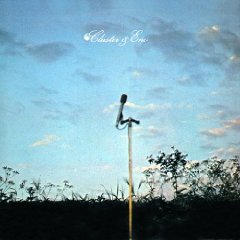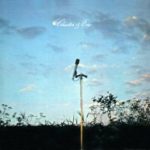
Harmonia ’76, Tracks & Traces
Cluster & Eno, Cluster & Eno
Eno Moebius Roedelius, After the Heat
*****
Brian Eno’s projects aren’t the magnets for attention that they once were. It’s what happens when an artist has been around for a while, and has had his once-revolutionary ideas become mainstream. In fact, they’ve been mainstream long enough that the bands who brought those ideas there are now among the influences of bands in the current mainstream.
In the ’70s, though—when Eno was a member of Roxy Music, made his own solo albums, and collaborated with Talking Heads, David Bowie, Devo, and others—his ideas about texture, and about taking things out when most of his contemporaries were putting more and more things in, were groundbreaking. They came from a variety of sources, and one of those sources appears to have been the German keyboard group Cluster. As a result, Eno collaborated with them over three albums around 1976 and 1978, exploring what would come to be known as ambient music. Previously known only to his more devoted collectors, they are now available again.
Tracks & Traces (actually collaboration between Eno and Harmonia, which consisted of Cluster plus guitarist Michael Rother) is the longest of these sets, and the only one not issued at the time of recording. It’s also the most diverse, although many of the tracks are in the same mold as the later two Cluster & Eno albums: long explorations of single chords or brief melodies or sequences. A few tracks are surprising: “Luneburg Heath” is an eerie synthscape with the only vocal of the disc (a repeated line from Eno), “Les Demoiselles” is a humorous piece using rhythms that resemble Casio presets, and “Weird Dream” is an electronic ramble unusually close to Tangerine Dream terrain.
Cluster & Eno, meanwhile, is the most thoroughly ambient of the three. The opening cut meditates on a D chord with simple piano and synth pulsing, while other tracks feature electronic textures that anticipate the coming New Wave sounds. However, ambient music is a subjective experience, and only a few of these sonic paintings are attractive enough to register – the recurring minor chords of “Fur Luise” irritate rather than entrance. “Selange” is an intriguing cut with an unusually stern mood, while “One” is a departure into sitar sounds.
After the Heat is similar, but here their musical explorations reach richer terrain. The ballads are more poignant, while the upbeat pieces are more urbane. As with Cluster & Eno, most of the disc is instrumental, but in the last three tracks Eno chants (“Broken Head”), sings (“The Belldog”) and sings backwards (“Tzima N’Arki”). “Broken Head” and “Tzima N’Arki” suggest a new, more dissonant direction for this group, but they would not explore it further, although Eno’s Before & After Science includes one more track with Cluster (“By This River”).
These three discs aren’t as striking as 1975’s Another Green World or 1977’s Before & After Science. Take them for what they are, though – research into new sonic directions and the result of a brief, spontaneous collaboration.



No Comments comments associated with this post